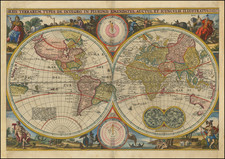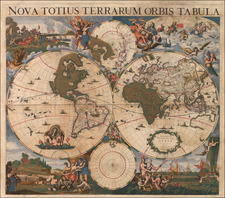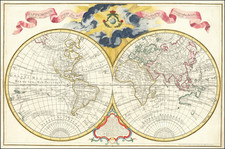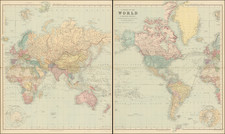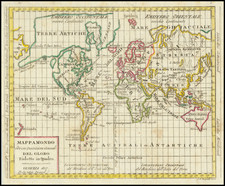Gorgeous example of Magini's map of the World, from his 1598 edition of Ptolemy. Magini's Ptolemy included 4 world maps, including an ancient world map, two classic Lafreri style maps and this modern double hemisphere world map, based upon Mercator's World Map of 1569. The map includes a classical late 16th Century configuration of the World, including a Northwest Passage, unusual depiction of the North Pole, massive Terrae Australis, narrow passage between South America and Terrae Australis, bulging western portion of South America and unusual treatment of North America, to name but a few of its features. Some of the placenames mentioned by Marco Polo in Asia are present, as are several of the mythical islands of the Atlantic. A nice decorative example in an attractive (probably later) hand coloring. Wide margins. A nice example. Shirley 194.
Giovanni Antonio Magini was an accomplished Italian cartographer, astronomer, astrologer, and mathematician—in short, a Renaissance man. Born in Padua, he studied philosophy in Bologna. His first publication was Ephemerides coelestium motuum, an astronomical treatise published in 1582. In 1588 he was selected, over Galileo Galilei, to fill the chair of mathematics at the University of Bologna. He died in that city in 1617.
Magini operated under a geocentric understanding of the universe and created his own planetary theory consisting of eleven rotating spheres. He published this theory in Novæ cœlestium orbium theoricæ congruentes cum observationibus N. Copernici (Venice, 1589). In the 1590s he published works on surveying and trigonometry, as well as invented a calculator. In 1596, he published a commentary of Ptolemy’s Geographia, which was published in several editions and languages. He labored for years on an atlas of Italy, which was printed posthumously in 1620. To pay for this project, Magini served as the math tutor to the son of the Duke of Mantua, as well as being the court astrologer to the Duke.









![[World] Dated Events War Map . . .](https://storage.googleapis.com/raremaps/img/small/88833.jpg)
